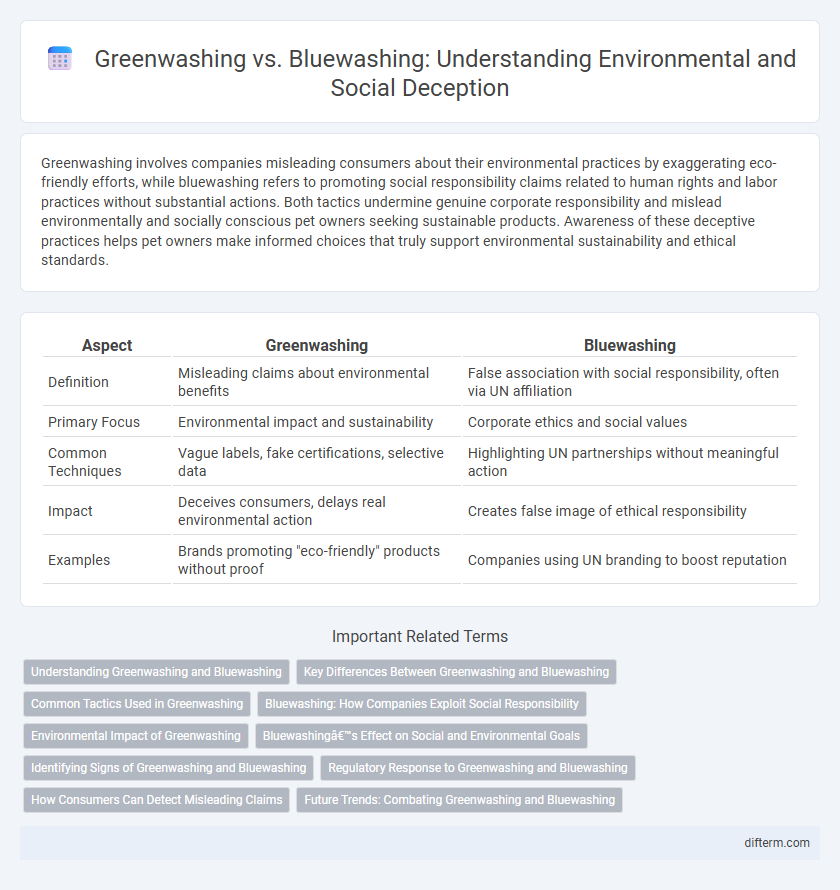Greenwashing involves companies misleading consumers about their environmental practices by exaggerating eco-friendly efforts, while bluewashing refers to promoting social responsibility claims related to human rights and labor practices without substantial actions. Both tactics undermine genuine corporate responsibility and mislead environmentally and socially conscious pet owners seeking sustainable products. Awareness of these deceptive practices helps pet owners make informed choices that truly support environmental sustainability and ethical standards.
Table of Comparison
| Aspect | Greenwashing | Bluewashing |
|---|---|---|
| Definition | Misleading claims about environmental benefits | False association with social responsibility, often via UN affiliation |
| Primary Focus | Environmental impact and sustainability | Corporate ethics and social values |
| Common Techniques | Vague labels, fake certifications, selective data | Highlighting UN partnerships without meaningful action |
| Impact | Deceives consumers, delays real environmental action | Creates false image of ethical responsibility |
| Examples | Brands promoting "eco-friendly" products without proof | Companies using UN branding to boost reputation |
Understanding Greenwashing and Bluewashing
Greenwashing involves companies misleading consumers by exaggerating or falsely claiming their environmental efforts, damaging genuine sustainability initiatives. Bluewashing, a related practice, occurs when organizations promote their commitment to social responsibility, linked to the United Nations Global Compact, without making substantial changes. Understanding these deceptive marketing tactics is crucial for consumers and stakeholders to identify authentic environmental and social responsibility practices.
Key Differences Between Greenwashing and Bluewashing
Greenwashing involves misleading claims about environmental benefits to appear sustainable, often exaggerating eco-friendly practices or hiding harmful impacts. Bluewashing, on the other hand, centers on falsely promoting social responsibility, especially regarding human rights and ethical governance, by leveraging affiliations with reputable organizations like the UN Global Compact. The key difference lies in greenwashing's focus on environmental deception versus bluewashing's focus on social and ethical image manipulation.
Common Tactics Used in Greenwashing
Common tactics used in greenwashing include misleading labels, vague claims like "eco-friendly" without proof, and selective disclosure that highlights positive environmental efforts while ignoring harmful practices. Companies often use green imagery and buzzwords to create a false impression of sustainability and shift consumer focus away from detrimental impacts. These deceptive strategies undermine genuine environmental initiatives and complicate consumer efforts to make informed, eco-conscious choices.
Bluewashing: How Companies Exploit Social Responsibility
Bluewashing refers to companies exploiting social responsibility by falsely portraying themselves as committed to ocean conservation and social causes, leveraging the symbolic power of the color blue associated with water and trust. These corporations often exaggerate their environmental and social initiatives, misleading consumers and stakeholders to gain reputational benefits without implementing substantial or transparent actions. This deceptive practice undermines genuine sustainability efforts and complicates efforts to hold organizations accountable for their true environmental impact.
Environmental Impact of Greenwashing
Greenwashing misleads consumers by falsely promoting a company's environmental credentials, which undermines genuine sustainability efforts and delays critical action against climate change. The environmental impact includes continued pollution and resource depletion, as greenwashing allows harmful practices to persist under the guise of eco-friendliness. Unlike bluewashing, which centers on social responsibility, greenwashing specifically damages trust in environmental initiatives and weakens regulatory enforcement.
Bluewashing’s Effect on Social and Environmental Goals
Bluewashing undermines genuine corporate commitments to social and environmental goals by promoting misleading claims about ocean conservation and social responsibility. This deceptive practice diverts attention and resources from impactful policies addressing marine sustainability and human rights. Companies engaged in bluewashing risk eroding trust among stakeholders and weakening overall progress toward achieving the United Nations Sustainable Development Goals.
Identifying Signs of Greenwashing and Bluewashing
Identifying signs of greenwashing and bluewashing involves scrutinizing company claims for vague language, lack of third-party certifications, and misleading visuals that exaggerate environmental or social commitments. Greenwashing often features generic eco-friendly terms without specific data or transparent reporting, while bluewashing exploits affiliations with reputable organizations to mask minimal sustainable practices. Consumers should look for verifiable metrics, independent audits, and clear, measurable goals to distinguish authentic efforts from deceptive marketing.
Regulatory Response to Greenwashing and Bluewashing
Regulatory responses to greenwashing and bluewashing have intensified globally, with authorities imposing stricter disclosure requirements and penalties for misleading environmental claims. The European Union's Corporate Sustainability Reporting Directive (CSRD) mandates transparent, verifiable sustainability reporting to combat deceptive practices. In parallel, the US Federal Trade Commission (FTC) enforces the Green Guides and is expanding oversight to include bluewashing by scrutinizing claims about social responsibility and ocean-related initiatives.
How Consumers Can Detect Misleading Claims
Consumers can detect misleading claims by scrutinizing company certifications and verifying if environmental statements align with actual business practices, such as emissions or energy use data. Look for transparency in sustainability reports and check for third-party audits that differentiate genuine greenwashing from misleading bluewashing, which focuses on social responsibility rather than environmental impact. Comparing product labels against recognized environmental standards like LEED or B Corp certifications helps identify authentic eco-friendly practices.
Future Trends: Combating Greenwashing and Bluewashing
Emerging technologies like blockchain and AI are enhancing transparency in environmental claims, making it harder for companies to engage in greenwashing and bluewashing. Regulatory frameworks worldwide are tightening, with stricter penalties and mandatory disclosures driving corporate accountability in sustainability reporting. Consumer demand for verified, credible environmental impact data fuels innovation in certification standards, promoting genuine commitments over superficial marketing.
greenwashing vs bluewashing Infographic

 difterm.com
difterm.com